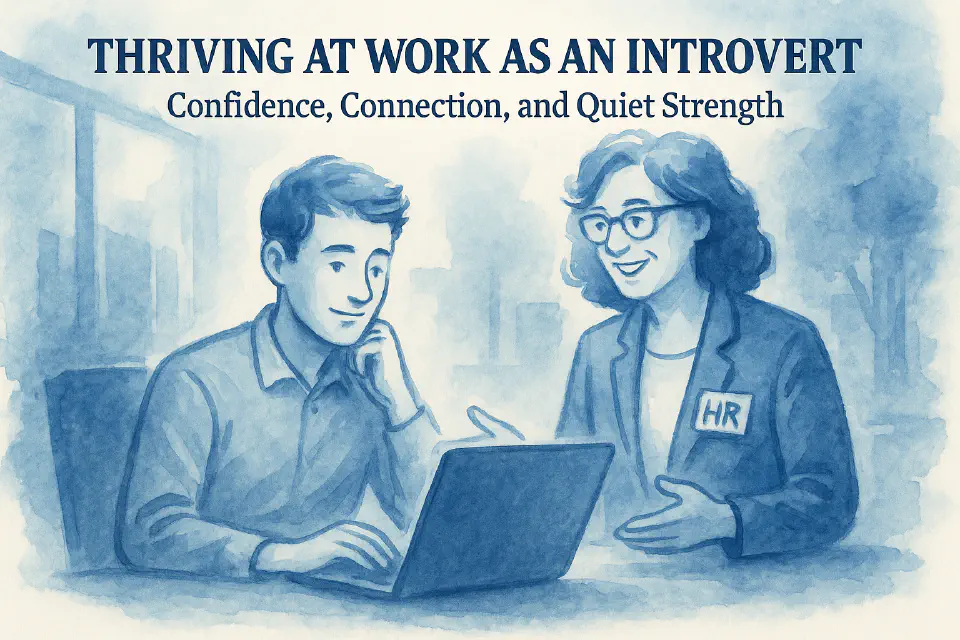
Thriving at Work as an Introvert: Confidence, Connection, and Quiet Strength
In a world designed for extroverts, introverts often feel like outsiders in their own workplace. But introversion isn't a weakness—it’s a quiet strength. This guide helps HR teams and employees create space where introverts can thrive.
In today’s workplaces—where visibility often equates to value—it’s easy to assume that louder voices get further ahead. But what if the most impactful contributions don’t come from the most vocal people? What if the quietest person in the room holds the insight everyone needs—but never gets the chance to speak?
For introverts, the modern workplace can feel like an ongoing performance in a play they never auditioned for. Open-plan offices, brainstorming sessions, all-hands meetings, after-hours socials—many environments and rituals are optimized for extroversion. But that doesn’t mean introverts can’t thrive. In fact, some of the most respected leaders, strategists, and creatives are quiet by nature. The difference lies not in personality, but in how the environment enables people to show up as themselves.
This article explores what it means to be an introvert at work today—and how both individuals and HR teams can make space for introverted talent to grow, lead, and succeed.
What Is Introversion—and What It Isn’t
Let’s clear one thing up: introversion is not shyness, and it’s definitely not a flaw. Psychologist Carl Jung, who first popularized the term in the early 20th century, described introverts as people who “turn inward” for energy, reflection, and clarity.
Introverts are often:
- Deep thinkers and listeners
- Reflective and analytical
- Sensitive to overstimulation
- Energized by solitude or small group interactions
They may not thrive in spontaneous group settings or fast-paced verbal exchanges—but that doesn’t mean they lack ideas or ambition.
Understanding introversion is the first step in creating inclusive, effective workplaces that don’t just tolerate but actively leverage diverse working styles.
Why the Workplace Often Feels Built for Extroverts
Modern corporate life rewards the assertive. Speaking up in meetings, participating in brainstorming sessions, “managing up”—these are coded extrovert behaviors. Many performance management systems unintentionally favor those who self-promote or dominate group dynamics.
It’s no coincidence that:
- Many sales and leadership roles are seen as a “better fit” for extroverts
- Open-plan offices offer little refuge for focus and reflection
- Traditional networking rewards surface-level connection over depth
These conditions create a performance pressure that doesn’t suit everyone.
The key is to design workplaces where introversion isn’t something to overcome—it’s something to respect.
Finding Comfort Before Confidence
When starting a new job, the common advice is to “fake it ‘til you make it.” But for many introverts, faking confidence only leads to burnout. A better approach? Focus on comfort first.
Michael Thompson, author of the original article this piece is based on, described how his first manager adapted the onboarding process when he noticed Thompson’s discomfort with public role-playing exercises. Rather than forcing him into a high-pressure setting, the manager offered a quiet corner, time, and encouragement. That small act of empathy changed everything.
Feeling comfortable is the foundation of contribution. And contribution builds confidence—not the other way around.
Communicate How You Best Communicate
Introverts often prefer written over verbal communication, time to reflect before speaking, and asynchronous collaboration. But these preferences don’t always match how work gets done—especially in fast-paced or remote teams.
One strategy? Be transparent.
Let colleagues know how you communicate best. Share that you may process information quietly, and follow up in writing. Clarify that silence doesn’t mean disinterest—it means reflection.
The more openly teams talk about how they work, the easier it becomes to build bridges across styles.
Reframing Networking: Depth Over Width
Networking doesn’t have to mean handing out 30 business cards at a conference or joining every social event. For introverts, the best connections are often one-on-one, and built over time.
Forget trying to “win the room.” Instead:
- Invite a colleague to lunch or coffee
- Schedule regular 1:1 walks with team members
- Follow up on a shared topic of interest after a meeting
By building authentic relationships at your own pace, you create a supportive network that doesn’t drain your energy.
Choosing Growth—One Challenge at a Time
Comfort is important—but so is growth. Once you feel grounded in your role, choose one area to stretch.
Maybe it’s:
- Asking a question in a meeting
- Giving a short presentation
- Joining a cross-functional project
- Taking the lead in a small group
Growth doesn’t have to mean transformation. It just means taking one step beyond what’s familiar.
By approaching development on your own terms, you gain skills without losing yourself.
Creating Space for Introverts: HR’s Role
HR professionals have an essential role in creating cultures where introverts can thrive. That doesn’t mean favoring introverts over extroverts—but recognizing that success doesn’t look the same for everyone.
Here are five key actions HR teams can take:
- Review performance criteria: Are “visibility” and “voice” overemphasized in performance reviews?
- Design inclusive meetings: Provide agendas in advance, encourage written input, and normalize silence as reflection.
- Create quiet spaces: Offer places for deep work and decompression—even in remote environments.
- Offer communication training: Help all employees understand and respect diverse styles.
- Normalize asynchronous collaboration: Use tools like Notion, Loom, or Trello to let people contribute on their own time.
By designing environments that honor reflection as much as participation, you unlock the full spectrum of talent on your team.
Embracing the Power of Quiet
The workplace of the future won’t be shaped by volume, but by value. And value comes in many forms—loud, quiet, verbal, written, spontaneous, and considered.
Introverts don’t need fixing. They need space.
Space to reflect. To contribute. To lead.
Let’s create workplaces where different voices don’t compete—but complete each other.
And let’s remember: success isn’t about who talks the most. It’s about who makes the most meaningful impact.